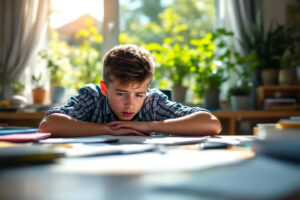Do You Know That Magical Moment When a Child Becomes Lost in Their Own World?
Perhaps they’re building a fort out of blankets and cushions, creating an adventure with invisible heroes, or sketching a picture brimming with imagination. These moments of free play are far more than mere “time fillers.” They are the key to healthy, holistic development—a wellspring of creativity, problem-solving skills, and self-confidence.
As neuroscientist Gerald Hüther explains: “When neither fear nor pressure is present, the joy of discovering and creating awakens. That’s how the brain works.”
Yet in our fast-paced, highly structured world, there is often little room left for such freedom. Children’s schedules are packed with schoolwork, sports activities, and extracurricular programs. This is precisely why it’s so important to reclaim unstructured playtime for them. In this article, we’ll delve into the importance of free play, explore why it’s so valuable for your child’s development, and offer tips on how to encourage it in daily life.
Why Unstructured Play Is the Key to Childhood
Unstructured play means children can play freely without guidance or set goals. It’s an activity driven purely by their curiosity and imagination. Perhaps you’ve seen it: a child starts playing with a pile of building blocks, and suddenly, it becomes a castle, a spaceship, or an entire kingdom. These moments are not just delightful to watch—they have a profound impact on a child’s development.
1. Creativity Flourishes
In free play, a child’s imagination thrives. Without instructions or strict rules, they can develop their own ideas. Perhaps they’ll draw a world where trees talk or invent a story with their toys that no adult could have imagined. This creative freedom not only provides an outlet for their imagination but also lays the foundation for future creative thinking—a skill essential in problem-solving and professional life.
2. Learning to Solve Problems
Unstructured play often presents challenges: How do you balance stones so they don’t fall? How do you build a stable fort? These small, everyday obstacles teach children to find solutions on their own. Unlike guided activities, where adults frequently intervene, free play allows them to act independently. That feeling of “I did it myself!” strengthens their confidence and resilience—qualities that will serve them for a lifetime.
3. Social Skills Through Free Play
When children play freely in groups, important social skills naturally emerge. They must communicate, resolve conflicts, and agree on roles. Who gets to be the captain of the pirate ship today? Who will play the dragon? Through these interactions, children learn to compromise and develop an understanding of others’ needs.
4. Boosting Emotional Health and Self-Confidence
In free play, children can be completely themselves. They can express their emotions without judgment and make their own decisions. This not only promotes emotional well-being but also helps them build a strong sense of self-confidence.
The Science of Free Play: Why Children Need It
Unstructured play fosters neural connections in the brain. These connections are crucial for developing creativity, cognitive skills, and emotional resilience. Furthermore, children who regularly engage in free play are more flexible and adaptable. In an ever-changing and unpredictable world, these abilities are invaluable.
But it’s not just science; personal experience also highlights the importance of free play. Ask yourself: When was your child last truly happy, carefree, and completely immersed in their own world? Chances are, it was during a moment of free play.
How Parents and Educators Can Encourage Unstructured Play
Life is often hectic, and many parents feel they’re not providing enough for their children. But the beauty of unstructured play is that it doesn’t require expensive toys or elaborate preparations. Often, all it takes is giving children time and space. Here are some tips:
1. Create Free Time
Schedule intentional periods without planned activities. Let your child decide how to spend this time, and take a step back yourself.
2. Use Natural Materials
Children don’t need high-tech toys to be creative. Simple materials like stones, sticks, blankets, or cardboard boxes can inspire their imagination and encourage creative thinking.
3. Resist the Urge to Intervene
It can be hard to watch a child struggle with a problem. But these moments are when they learn to act independently. Step back and observe how your child finds their own solutions.
4. Limit Screen Time
Digital media can be valuable but often stifles imagination. Set aside intentional periods for your child to disconnect and explore the world around them.
5. Use Nature as a Playground
Nature offers endless opportunities for unstructured play. Climbing trees, digging in the sand, or exploring a stream allows children to unleash their creativity.
Free Play in Schools: An Underestimated Potential
Unstructured play should also be encouraged in schools. Free recess periods or open play spaces provide children with much-needed breaks from their tightly scheduled school days. Projects that allow children to decide what they want to do can also create valuable opportunities for self-directed exploration.
Schools that integrate free play into their routines often report improved social interactions and increased focus in class. It’s worth considering how educational institutions can give children more freedom to play.
Unstructured Play as a Gift: A Childhood Full of Imagination and Growth
In a world often driven by achievement and efficiency, unstructured play is a gift—not just for children but also for parents. It reminds us of the importance of making time for simple, spontaneous moments in life.
By giving children the freedom to play, we offer them far more than just fun. We give them the opportunity to grow, develop their personalities, and explore life in all its richness.
So, clear the living room for a pillow fort. Let your child embark on a treasure hunt in the backyard. And cherish the joy that lights up their eyes. These are the moments that define childhood—and that prepare our children to face the future with strength and confidence.




